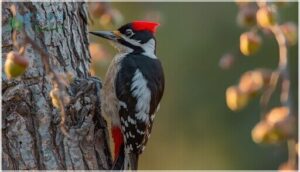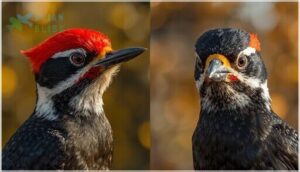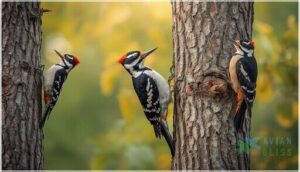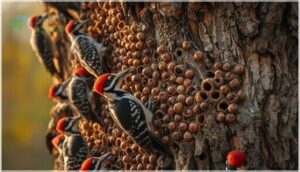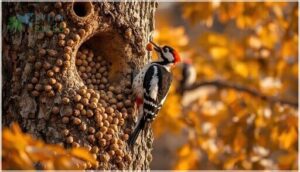This site is supported by our readers. We may earn a commission, at no cost to you, if you purchase through links.
A woodpecker that lives in communes and hoards thousands of acorns like a feathered prepper—meet the acorn woodpecker, nature’s rebel with a cause. These black-and-white clowns of the oak forests don’t just survive together; they’ve built entire societies around shared granaries, cooperative breeding, and collective defense. While most birds jealously guard resources, acorn woodpeckers figured out that freedom comes through collaboration.
Each family group drills custom storage holes in “granary trees,” sometimes creating over 50,000 perfectly fitted pockets in a single trunk. Their white-eyed stare and raucous calls announce their presence across western oak woodlands, where they’ve turned acorn storage into an art form that sustains them year-round.
Table Of Contents
- Key Takeaways
- Acorn Woodpecker Identification
- Habitat and Geographic Range
- Unique Behavior and Social Structure
- Diet and Feeding Habits
- Conservation Status and Threats
- Frequently Asked Questions (FAQs)
- What is the difference between a red headed woodpecker and an Acorn Woodpecker?
- Why are acorn woodpeckers endangered?
- Where are acorn woodpeckers found?
- What do acorn woodpeckers do with acorns?
- How do acorn woodpeckers choose their nesting trees?
- What unique storage habits do acorn woodpeckers have?
- How do acorn woodpeckers maintain their food supplies?
- Do acorn woodpeckers interact with other bird species?
- How do acorn woodpeckers adjust to environmental changes?
- How long do acorn woodpeckers typically live?
- Conclusion
Key Takeaways
- Acorn woodpeckers operate in cooperative breeding groups of up to 15 members, sharing granary maintenance, territorial defense, and childcare duties—a social structure that contradicts typical solitary bird behavior and maximizes reproductive success at 7-8 members per territory.
- Their specialized granary trees contain up to 50,000 custom-drilled storage holes built across generations, with each bird caching roughly 325 acorns annually to achieve an 86.7% storage success rate that sustains the group through winter months when insects disappear.
- These birds display dramatic seasonal diet shifts, moving from 50% acorn consumption year-round to 38-40% insect foraging during breeding season, demonstrating flexible omnivorous feeding strategies that include aerial flycatching, sap feeding, and opportunistic predation.
- Despite a stable population of 7.5 million and “Least Concern” conservation status, habitat fragmentation has isolated 24% of territories, with oak woodland decline in California’s Willamette Valley threatening the mature forests and granary sites essential for their cooperative lifestyle.
Acorn Woodpecker Identification
You’ll know an Acorn Woodpecker when you see one—they’re the wild-eyed clowns of the oak forest. Their bold patterns and quirky posture make them stand out from other woodpeckers.
Here’s what to look for when identifying these acorn-hoarding rebels in the field.
Physical Features and Plumage
You’ll spot this feisty rebel by its striking plumage and bold color pattern. The bird’s physical features include:
- Brownish-black back and wings with white rump patches visible in flight
- White belly marked with black stripes running vertically
- Straight, spike-like beak structure and wedge-shaped tail features for gripping bark
Adult acorn woodpecker characteristics include distinctive white eye colors that create their famous clown-faced look.
The acorn woodpecker’s social structure is centered around complicated family groups.
Distinctive Head Patterns
The head pattern is where the real magic happens. Males wear a continuous red cap flowing right into their white forehead—no interruptions. Females rock a black cap with red pushed back, creating a distinct band.
Both sexes flash that unmistakable “clown mask” effect: white forehead, black eye stripe, and those wild white irises staring back at you. It’s visual identification made easy.
Size and Shape Comparison
You’ll find the Acorn Woodpecker lands right in the middle of the woodpecker size chart—bigger than a Downy but noticeably smaller than a Northern Flicker. Think robin-sized at 7.5-9.1 inches long. You’re looking at a compact, sturdy bird with that signature spike-like beak and stiff wedge tail propping it against tree trunks.
- Wingspan stretches 13.8-16.9 inches—perfect for quick bursts between oaks
- Weight clocks in at 2.3-3.2 ounces—solid enough for serious drilling
- Body proportions scream “climber”—built for vertical living, not ground feeding
Their unique characteristics are well-suited for their woodpecker species habits.
Male Vs Female Differences
You can tell males from females instantly—the male woodpecker sports a red cap flowing straight to his white forehead, while the female woodpecker shows a black band cutting between her red crown and forehead. This head pattern offers 100% accuracy in bird plumage and color patterns identification.
Despite these plumage variation differences, both sexes share parental duties equally—no sex role reversal here, just cooperative teamwork in their mating behaviors and reproductive strategies.
Juvenile Characteristics
When you’re watching a young acorn woodpecker, you’ll notice duller plumage overall—the belly shows light tan instead of bright white. Juvenile plumage displays brownish breast streaks and dark eyes that lighten through molting patterns over several months.
More than 70% of first-year birds show white tail spots, a feather structure detail that disappears in adults. They’re smaller and less glossy too.
Habitat and Geographic Range
You’ll find acorn woodpeckers across western North America, but they’re not just wandering anywhere. These birds stick to specific landscapes where oak trees thrive and acorns are plentiful.
Let’s break down where they live and why those places work for their unusual lifestyle.
Preferred Oak Woodlands and Forests
You’ll spot these oak habitat specialists thriving in woodlands where canopy cover hits that sweet spot between 30 and 70 percent. Think of it as their Goldilocks zone—not too dense, not too sparse.
Here’s what defines ideal acorn woodpecker habitat:
- Mixed oak species diversity buffers against crop failures when one species has a bad year
- Mature trees exceeding 45.5 cm diameter provide prime real estate for granary trees and roosting
- Dense midstory structure with 25% cover creates the layered woodland ecology they need to flourish
Range in North America
From southern Washington down through California and sweeping east into Colorado, New Mexico, and western Texas, you’ll find acorn woodpeckers holding court year-round. These birds don’t migrate—they’re committed homebodies.
Seven regional subspecies carve up North America’s range, each adapted to local oak woodlands. Geographic boundaries track elevation limits from sea level to 6,900 feet, with scattered mountain populations defying habitat fragmentation across the Southwest’s isolated ranges.
Urban and Suburban Adaptation
You’ll spot these adaptable birds drilling into telephone poles, wood siding, and fence posts where oak woodlands meet human development. Urban foraging brings acorn woodpeckers into conflict with property owners when they modify structures for storage.
Suburban nesting succeeds in parks with mature oaks and open canopies. Larger woodland patches support stable populations, though fragmentation challenges their cooperative breeding system.
They’re year-round residents, not adaptive migrants.
Elevation and Terrain Preferences
You’ll find acorn woodpeckers thriving from sea level to timberline, but they stick where oaks deliver. In California, they own oak woodlands below 2,100 m year-round. Central America’s populations climb above 1,000 m.
Mountain habitats and canyon systems with open stands, mature oaks, and mixed terrain work best. Elevation zones shift with acorn availability—these woodpecker species follow the food, not arbitrary boundaries.
Unique Behavior and Social Structure
Acorn Woodpeckers break every rule you thought you knew about bird behavior. These charismatic clowns don’t just survive alone—they’ve built entire societies around shared resources and collective childcare.
Acorn Woodpeckers shatter expectations by building entire societies around shared resources and collective childcare
Here’s what makes their social world so different from most birds you’ll encounter.
Cooperative Breeding Groups
You’ll witness something radical in acorn woodpecker behavior: these birds shatter the solo survival myth through cooperative breeding groups of up to 15 members. Their communal living redefines family.
- Groups average 4.5 birds with 1-4 breeding males and up to 3 females
- Genetic relatedness drives bird parental care as helpers raise siblings’ offspring
- Reproductive success peaks at 7-8 members per territory
- Social structure allows territory inheritance of valuable granary resources
This communal nesting strategy delivers real freedom through shared responsibility.
Acorn Caching and Granary Trees
The cooperative spirit you’ve seen extends to their legendary acorn storage—each woodpecker caches around 325 acorns yearly in granary trees. These structures hold up to 50,000 holes, taking a century to build across generations.
Caching location flexibility matters: they’ll use living oaks, dead snags, even buildings when needed. Storage success rates hit 86.7% annually, proving this Acorn Woodpecker diet strategy works brilliantly.
Daily Foraging and Roosting Habits
You’ll see their Acorn Woodpecker foraging habits shift throughout the day—they harvest acorns in fall, then sally from branches to snag insects mid-air. These foraging strategies include gleaning bark for ants and sap, with acorns providing half their annual diet.
Social foraging involves coordinated territorial defense against jays while groups share multiple excavated roost cavities at night, maintaining warmth together year-round.
Diet and Feeding Habits
You might think acorn woodpeckers live on acorns alone, but their diet tells a more complex story. These birds are resourceful eaters who shift their menu based on what’s available throughout the year.
Here’s what fuels their busy social lives and how they manage their famous food stores.
Primary Food Sources
Acorns form the cornerstone of your woodpecker’s diet, making up roughly 50% of what they eat year-round.
You’ll find them hunting insects—especially flying ants and beetles—during warmer months, showcasing impressive aerial foraging behavior.
They’ll also supplement their nutrition with fruits, oak catkins, and sap from defended trees.
Occasionally, they’ll snatch eggs or small lizards when the opportunity arises, demonstrating their truly omnivorous appetite.
Acorn Storage and Retrieval
Beyond simply gathering food, you’ll witness something remarkable in how these woodpeckers manage their granary trees. Each family drills thousands of custom-fit holes—averaging 325 acorns stored per bird annually—creating what looks like nature’s wine rack.
Their storage strategies guarantee food security through lean winter months. You’ll see them making repeated trips during peak harvest season, carefully placing each acorn for easy retrieval when insects disappear.
Insect and Fruit Consumption
While acorns dominate their reputation, you’ll find these birds hunting flying insects mid-air with surprising agility. Insect foraging peaks during breeding months when protein-rich ants and beetles comprise 38-40% of their annual diet.
They’re true omnivores, supplementing stored acorns with fruit sources from woodland shrubs. This dietary adaptation through nutrient acquisition from diverse feeding behavior keeps their cooperative groups thriving year-round.
Seasonal Changes in Diet
You’ll notice a dramatic shift in feeding behavior as seasons change. Spring brings peak insect foraging, with flycatching dominating their daily routine.
Summer triggers increased sap feeding as insect numbers drop.
Fall marks intense acorn storage preparation—this omnivore’s annual diet pivots entirely toward food caching.
By winter, stored acorns sustain survival while other dietary adaptation strategies take a back seat to their granary reserves.
Conservation Status and Threats
You’ll be glad to know that acorn woodpeckers aren’t in any immediate danger. With 7.5 million birds holding steady across their range, these resourceful storage experts have earned a “Least Concern” status.
But like any species tied to specific habitats, they face real challenges that could shift the balance if we’re not paying attention.
Current Population and Trends
You’re looking at a species that’s holding steady. The Acorn Woodpecker’s global population hovers around 7.5 million individuals, with Trend Analysis showing stable or slightly increasing numbers.
Though it’s currently Least Concern, don’t be fooled—Habitat Impact from oak woodland decline threatens future stability.
Conservation Efforts focus on protecting mature forests where these birds thrive, ensuring their cooperative lifestyle continues flourishing across western landscapes.
Habitat Loss and Fragmentation
You can’t protect what’s already vanished. Oak woodland decline hits hard—California’s Willamette Valley has lost prime habitat to agriculture and development, while fragmentation effects now isolate 24% of the remaining territory. Land use impacts keep shrinking the acorn-rich forests these cooperative groups need. Consider what’s at stake:
- Dispersal constraints trap isolated populations in low-quality patches
- Habitat loss eliminates granary trees essential for survival
- Slow oak regeneration means decades before new territories form
- Conservation responses focus on restoration corridors and replanting efforts
Bird habitat management requires thinking generations ahead for Oak woodland conservation.
Competition and Predation
Survival isn’t a solo act—it’s a battlefield. Granary competition from Steller’s jays forces aerial confrontations in 90% of encounters, while European starlings steal nest holes in urban zones. Intraspecific strife runs deeper: co-nesting females destroy 25% of eggs in shared nests. Avian predators like sharp-shinned hawks trigger silence and hiding. Behavioral responses, including vigilance spikes and group defense, directly shape survivorship trends across acorn woodpecker habitats.
| Threat Type | Primary Competitor/Predator | Impact on Population |
|---|---|---|
| Granary Competition | Steller’s Jays | Acorn theft at storage sites |
| Nest Competition | European Starlings | Reduced nesting success |
| Avian Predators | Sharp-shinned Hawks, Cooper’s Hawks | 7.9% juvenile mortality annually |
Conservation Efforts and Protection
You can’t save what you don’t protect. Habitat restoration strategies and legal protection now anchor acorn woodpecker conservation across western oak woodlands:
- Habitat restoration includes California’s fuels reduction protocols that identify and protect granary trees, while Oregon’s Conservation Strategy prioritizes oak woodland restoration with private landowners.
- Research programs track population trends through GPS tagging and nest monitoring in East Bay parks, informing ecosystem management plans.
- Community engagement drives landowner conservation efforts via workshops, citizen science mapping, and sustainable land management incentives for bird species conservation.
Frequently Asked Questions (FAQs)
What is the difference between a red headed woodpecker and an Acorn Woodpecker?
Can you tell them apart? Red-headed Woodpeckers sport solid crimson heads and pure white underparts, while Acorn Woodpeckers flash clownish white faces with black-backed red crowns—plumage comparison reveals striking differences in bird identification.
Why are acorn woodpeckers endangered?
They’re not endangered. Current conservation status sits at Least Concern, with 5 million birds thriving.
Still, habitat degradation, oak diseases, nest competition from starlings, and climate impacts threaten long-term stability despite healthy numbers today.
Where are acorn woodpeckers found?
You’ll find these woodpeckers across western North America—from Washington through California to Texas—and into Central American highlands.
They thrive in oak woodlands with open understories, adapting even to urban parks where mature oaks stand.
What do acorn woodpeckers do with acorns?
You’ll find acorns packed tight into custom-drilled granary holes—sometimes 50,000 per tree. This cooperative food storage system lets colonies survive winter without migrating, defending their cache year-round against thieves.
How do acorn woodpeckers choose their nesting trees?
In western New Mexico, one group claimed a towering Gambel oak—56% of their neighbors did the same.
You’ll spot these birds choosing large snags with soft, decayed wood for cavity excavation, prioritizing tree size and landscape factors near acorn-rich zones.
What unique storage habits do acorn woodpeckers have?
You’ll witness Woodpecker behavior and habitat like no other in oak woodlands.
These birds drill thousands of holes in granary tree construction, storing acorns with group cooperation. Storage capacity reaches 50,000 per site through seasonal patterns and site adaptation.
How do acorn woodpeckers maintain their food supplies?
You’ll find these birds defend their acorns like medieval treasure. They drill thousands of storage holes in granary trees, shift diets seasonally, and cooperatively guard their oak woodland stashes from raiders year-round.
Do acorn woodpeckers interact with other bird species?
You’ll notice plenty of interspecies competition around their granary defense zones. Steller’s jays raid acorn stores constantly, triggering aggressive aerial displays.
Sharp-shinned hawks prompt predator avoidance behavior, while social cognition helps these communal groups track rival bird coalitions.
How do acorn woodpeckers adjust to environmental changes?
You’ll see these birds shift their social groups when acorns fail, moving to cities when climate synchrony disrupts food supplies.
Fire adaptation includes behavioral changes during smoky conditions, affecting their population dynamics and habitat preferences.
How long do acorn woodpeckers typically live?
You’ll find these clownish birds living an average of 4-5 years in the wild. Males outlast females slightly.
Record-breakers reach 17 years, though most don’t see their 12th birthday due to predation and resource competition.
Conclusion
Most birds hoard alone in silence. The acorn woodpecker thrives through noise, collaboration, and 50,000 shared acorns drilled into communal fortresses. You’ve seen how these clown-faced rebels defy avian norms—cooperative breeding, collective defense, granary maintenance that spans generations.
Their white-eyed stare isn’t madness; it’s the look of a species that cracked the code: true independence requires interdependence. Next time you hear their raucous calls echoing through oak woodlands, you’re witnessing nature’s most successful experiment in organized freedom.


